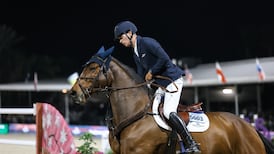Lance Armstrong has been swallowing some more pride this week, probably still hoping that it’s not poison. Full disclosure of the most sophisticated doping programme in sporting history doesn’t come easy, even to those with nothing left to lose.
“I’m just hopeful that I can regain trust, and get back to some work,” he told Daniel Benson, in a four-part interview with cyclingnews.com - his first face-to-face sit down with a specialist cycling journalist since the USADA’s Reasoned Decision, a year ago, sent millions of yellow wristbands flying into the dustbin. Not that Armstrong has completely surrendered on his past.
“If your question is, are they going back up on the wall, the answer is yes,” Armstrong added, when asked what he intended on doing with his seven yellow jerseys from the Tour de France. He’s currently decorating a new house in the suburbs of Austin, and Armstrong sees no reason why the jerseys wouldn’t look good hanging somewhere the dining room.
"What earned us those jerseys was hard work, the team, the tactics, the leadership, the technology the training, are also the things people poke fun of," he said.
Not ashamed
"They say 'this asshole told us it was the training, it wasn't the training it was the doping'. (It was) all of those things combined. We did all of those things. So when I see those jerseys, all of the stories that were told were true, about the hard work, the team. And I'm not ashamed of them. I'm upset that we were all put in that position and that we made those mistakes."
This is part of the old argument that whatever about working, the drugs don’t do all the work, especially if everyone at work is taking them. How much of this is true in Armstrong’s case we will never know. The worry is that the message doesn’t seem to be getting across, that anti-doping isn’t just about keeping the likes of Armstrong out of sport, but every little cheater, even the likes of Tomas Rauktys.
Rauktys has just been found guilty of possibly the least sophisticated doping programme in sporting history, and yet his case perhaps carries as strong a warning sign: if club or so-called amateur athletes are still tempted to play around with doping products, what hope have we got for the pros?
The 28-year-old Lithuanian native has been living in Dublin for the last five years, although has never represented Ireland, nor indeed was he eligible: however, Rauktys has been representing Clonliffe Harriers since 2009, and won the shot, discus and 56lb weight-for-distance at the National Championships in Santry last July, having also won six further titles, since 2010. It was here Rauktys was subjected to random doping test, carried out by the Irish Sports Council, on behalf of Athletics Ireland.
Two weeks later, Rauktys was notified of an anti-doping violation, his sample revealing traces of the anabolic agent hydroxystanozolol glucuronide, “consistent with the administration of the prohibited substance stanozolol”.
Stanozolol is one of the most detectable if not recognisable steroids, the same substance Canadian sprinter Ben Johnson tested positive for after the 100 metres at the Seoul Olympics, 25 years ago. Not surprisingly, Ruaktys did not request any analysis of his "B" sample. His case then went to the Irish Sport Anti-Doping Disciplinary Panel, where he made a written submission, explaining why the drug showed up where it did.
Believed legal
Under Irish Sports Council policy, the details of this disciplinary process were also revealed, along with his positive test, and Rauktys has in fact confessed to swallowing lots a drugs, all of which he believed were perfectly legal: "Creatine, protein, amino acids, pre-workout and post-workout mixes, sleep enhancers, vitamins, BCAA, joint activity enhancers . . . and all of this consists of a single day. I consume about 27-34 pills a day, plus mixes."
He later clarified his written statement explaining how he crushed the various pills into powder form, so as to not overload the stomach. He also claimed the stanozolol pills were given to him, along with several nutritional supplements, by an acquaintance at a gym in Dublin.
The problem, it appeared, was that he kept all his supplements together on the one shelf, and one day asked his wife to mix them up, to save time, instructing her “to include what remained of several substances into one mix”. He didn’t blame his wife for mixing the stanozolol in by accident, simply because she didn’t know any better, and because that wasn’t going to get him off the hook, either.
Ruaktys is now banned for two years, while Athletics Ireland goes about redistributing his three national titles won in Santry this year – Galway’s Sean Breathnach now set for the shot title.
It all seems a harmless enough case, meaningless or even insignificant compared to some high-profile Jamaican sprinter or Russian thrower testing positive, although not necessarily so.
According to the International Anti-Doping Database, Ireland has now registered 38 doping cases, above average for a country of our size.
Supplement culture
What this may actually provide is further evidence that the Irish Sports Council's Anti-Doping Programme is simply doing the job it is meant to do, while other countries, of similar size, have long way to go before catching up.
It is at the very least another warning too against the sports supplement culture, what may or may not get mixed up in it, accidentally or otherwise, that the so-called war on doping is as much about maintaining proper deterrent, all the way down the line, and that everyone in sport needs to know exactly what they’re swallowing.












